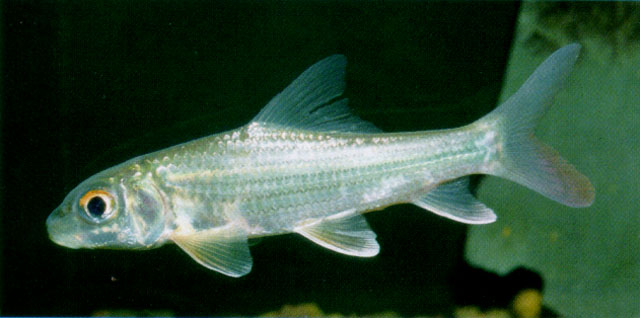| Cyprinidae (Minnows or carps), subfamily: Probarbinae |
| 150 cm SL (male/unsexed); max.weight: 70 kg |
|
demersal; freshwater; brackish, potamodromous |
| Asia: Mekong, Chao Phraya and Meklong basins of Indo-China and Thailand, and the Pahang and Perak basins of Malaysia (Ref. 7427). Catch, trade and transportation forbidden in Laos (Ref. 12217). |
|
Dorsal soft rays (total): 13-13; Anal soft rays: 8-8. Differs from P. labeamajor in having only 5 (instead of 6) stripes between lateral line scale row and dorsal fin base; lips not enlarged, free posterior margin of lower lip interrupted at midline; large adults without mentum; maxillary barbel invariably well developed, length one-third or more of eye diameter. The only species in which body stripes may extend to every scale row, but this only occurs in some larger and more darkly pigmented individuals. P. labeamajor and P. labeaminor have no more than three stripes below lateral line scale row, and the abdomen is uniformly white. Adults and larger juveniles of P. jullieni usually have much more red and sometimes yellow coloration on head, body, and fins than the other two species. Scale rows between lateral line scale row and pelvic fin 4. |
| Inhabits mainly the mainstream of large rivers (Ref. 10431), with sand or gravel substrates and abundant mollusks populations (Ref. 12693). Occurs in deep slow reaches (Ref. 37769). Feeds on aquatic plants, insects and shelled mollusks. Spawns in winter (late December-early February) in big riverine deltas over sand and gravel substrate with water current of 1.3 m/sec (Ref. 6459). Undertakes spawning and trophic migrations in the Mekong basin. Trophic migrations occurs throughout its occurrence range which takes place mainly at the onset of the flood season and are mainly undertaken by juveniles and subadults (Ref. 37770). Upstream spawning migrations take place between October and February from Kompong Cham in Cambodia to Chiang Khong in Thailand. At Chiang Khong , fishermen reported that Probarbus moves up the tributary Nam Ta in Laos to breed in March-April. Three Probarbus species were also reported to migrate together, but spawn separately, in January-February at Sungkom, Nong Khai Province in Thailand (Ref. 37770). Egg is buoyant, yellow and 2 mm in diameter. Hatching occurs in 32 hrs at 23°C (Ref. 6459). An excellent foodfish, sometimes consumed raw, but rather scarce so it fetches a high market price (Ref. 2686). Eggs are especially priced (Ref. 12369). Used to be cultured commercially in Thailand (Ref. 7306). May be caught individually or in small numbers of any size incidentally with gillnetting and other fishing activities, at virtually any time or place in the Mekong mainstream (Ref. 10431), but mostly caught during November-January spawning migration, when it is by far the most important species in fisheries catch (Ref. 12369). In the Mekong this important fisheries species is under serious long-term decline and this decline evidently is basin wide and the most obvious (but not necessarily only) reason is overfishing with gillnets during the reproductive migrations and spawning periods (Ref. 10431). Attains 70 kg or more, but mostly marketed size nowadays are 5-20 kg (Ref. 12369). |
|
Critically Endangered (CR); Date assessed: 29 January 2019 (A2d) Ref. (130435)
|
| harmless |
|
Source and more info: www.fishbase.org. For personal, classroom, and other internal use only. Not for publication.

